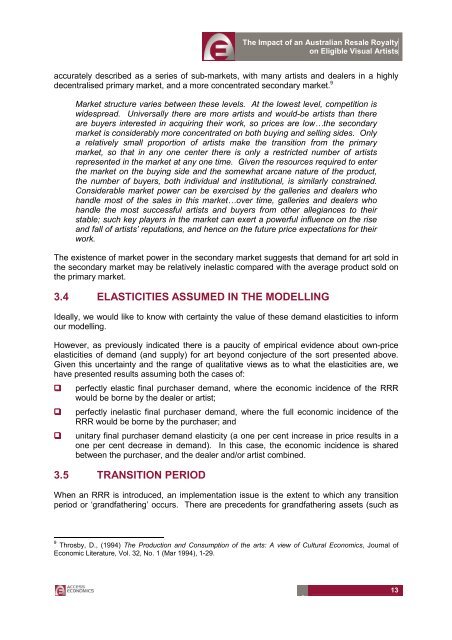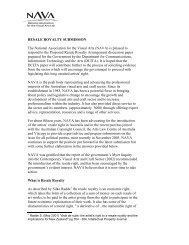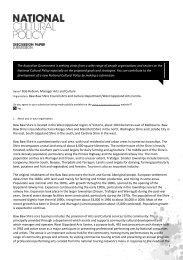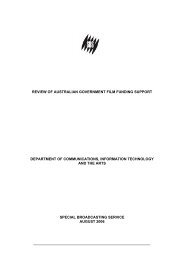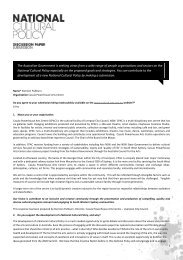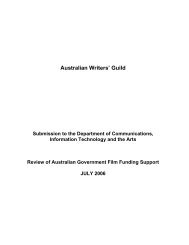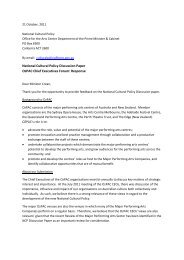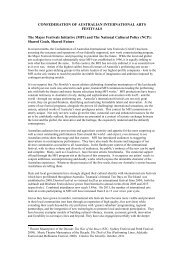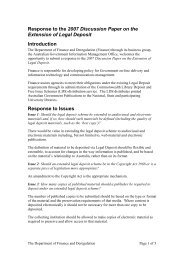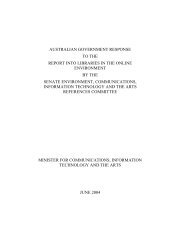evaluating the impact of an australian resale ... - Office for the Arts
evaluating the impact of an australian resale ... - Office for the Arts
evaluating the impact of an australian resale ... - Office for the Arts
You also want an ePaper? Increase the reach of your titles
YUMPU automatically turns print PDFs into web optimized ePapers that Google loves.
The Impact <strong>of</strong> <strong>an</strong> Australi<strong>an</strong> Resale Royaltyon Eligible Visual Artistsaccurately described as a series <strong>of</strong> sub-markets, with m<strong>an</strong>y artists <strong>an</strong>d dealers in a highlydecentralised primary market, <strong>an</strong>d a more concentrated secondary market. 9Market structure varies between <strong>the</strong>se levels. At <strong>the</strong> lowest level, competition iswidespread. Universally <strong>the</strong>re are more artists <strong>an</strong>d would-be artists th<strong>an</strong> <strong>the</strong>reare buyers interested in acquiring <strong>the</strong>ir work, so prices are low…<strong>the</strong> secondarymarket is considerably more concentrated on both buying <strong>an</strong>d selling sides. Onlya relatively small proportion <strong>of</strong> artists make <strong>the</strong> tr<strong>an</strong>sition from <strong>the</strong> primarymarket, so that in <strong>an</strong>y one center <strong>the</strong>re is only a restricted number <strong>of</strong> artistsrepresented in <strong>the</strong> market at <strong>an</strong>y one time. Given <strong>the</strong> resources required to enter<strong>the</strong> market on <strong>the</strong> buying side <strong>an</strong>d <strong>the</strong> somewhat arc<strong>an</strong>e nature <strong>of</strong> <strong>the</strong> product,<strong>the</strong> number <strong>of</strong> buyers, both individual <strong>an</strong>d institutional, is similarly constrained.Considerable market power c<strong>an</strong> be exercised by <strong>the</strong> galleries <strong>an</strong>d dealers whoh<strong>an</strong>dle most <strong>of</strong> <strong>the</strong> sales in this market…over time, galleries <strong>an</strong>d dealers whoh<strong>an</strong>dle <strong>the</strong> most successful artists <strong>an</strong>d buyers from o<strong>the</strong>r allegi<strong>an</strong>ces to <strong>the</strong>irstable; such key players in <strong>the</strong> market c<strong>an</strong> exert a powerful influence on <strong>the</strong> rise<strong>an</strong>d fall <strong>of</strong> artists’ reputations, <strong>an</strong>d hence on <strong>the</strong> future price expectations <strong>for</strong> <strong>the</strong>irwork.The existence <strong>of</strong> market power in <strong>the</strong> secondary market suggests that dem<strong>an</strong>d <strong>for</strong> art sold in<strong>the</strong> secondary market may be relatively inelastic compared with <strong>the</strong> average product sold on<strong>the</strong> primary market.3.4 ELASTICITIES ASSUMED IN THE MODELLINGIdeally, we would like to know with certainty <strong>the</strong> value <strong>of</strong> <strong>the</strong>se dem<strong>an</strong>d elasticities to in<strong>for</strong>mour modelling.However, as previously indicated <strong>the</strong>re is a paucity <strong>of</strong> empirical evidence about own-priceelasticities <strong>of</strong> dem<strong>an</strong>d (<strong>an</strong>d supply) <strong>for</strong> art beyond conjecture <strong>of</strong> <strong>the</strong> sort presented above.Given this uncertainty <strong>an</strong>d <strong>the</strong> r<strong>an</strong>ge <strong>of</strong> qualitative views as to what <strong>the</strong> elasticities are, wehave presented results assuming both <strong>the</strong> cases <strong>of</strong>:perfectly elastic final purchaser dem<strong>an</strong>d, where <strong>the</strong> economic incidence <strong>of</strong> <strong>the</strong> RRRwould be borne by <strong>the</strong> dealer or artist;perfectly inelastic final purchaser dem<strong>an</strong>d, where <strong>the</strong> full economic incidence <strong>of</strong> <strong>the</strong>RRR would be borne by <strong>the</strong> purchaser; <strong>an</strong>dunitary final purchaser dem<strong>an</strong>d elasticity (a one per cent increase in price results in aone per cent decrease in dem<strong>an</strong>d). In this case, <strong>the</strong> economic incidence is sharedbetween <strong>the</strong> purchaser, <strong>an</strong>d <strong>the</strong> dealer <strong>an</strong>d/or artist combined.3.5 TRANSITION PERIODWhen <strong>an</strong> RRR is introduced, <strong>an</strong> implementation issue is <strong>the</strong> extent to which <strong>an</strong>y tr<strong>an</strong>sitionperiod or ‘gr<strong>an</strong>dfa<strong>the</strong>ring’ occurs. There are precedents <strong>for</strong> gr<strong>an</strong>dfa<strong>the</strong>ring assets (such as9 Throsby, D., (1994) The Production <strong>an</strong>d Consumption <strong>of</strong> <strong>the</strong> arts: A view <strong>of</strong> Cultural Economics, Journal <strong>of</strong>Economic Literature, Vol. 32, No. 1 (Mar 1994), 1-29.13


